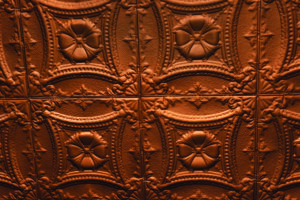(Editor’s note: DeeDee Wood is the owner of Black Cat Curiosities, an online antiques research and sales venue.)
Some of the finest homes in 19th century Europe made a statement with their plasterwork ceilings. Extensive labor, expertise and time-consuming processes were costly and available to only the wealthiest of estate owners.
Tin ceilings were an alternative in the United States, as an affordable option to the look of expensive plasterwork without the prohibitive costs.
The use of tin to mimic decorative plaster carried several advantages.
Tin was lightweight, easier to install, and offered the look of plaster without the intensive labor costs to install wet, heavy plaster.
The growing middle class wanted design elements their European counterparts presented in their homes, and tin, with versatile adornment options, was often painted white to appear as plaster to the untrained eye.
The process of making the same pattern on thin tin sheeting involved using a press that dropped tin down onto cast iron molds (called “rope drop hammers,”) one at a time, to make the same pattern over and over.
The sheet was in between the pressing agent and the mold, making a permanent embedding of the pattern.
Not only did the manufacturer need to make flat sheets for the ceiling, called “field panels, ”but also filler panels, that made a border around the field panels, and finally cornices, or the pieces that transitioned the tin from the ceiling to the wall — which included corner pieces.
Patterning and design for the ceilings were often repeating and highly decorative, but could also be a solid central circle, symmetrical or one large design, if extra was paid to make exclusive patterns.
Greek and Roman patterns and images were often used, as the Victorians were partial to these time periods in history in their decorative options in homes, a nod to literature, poetry, sculpture and the quest for knowledge.
The patterns were transferred onto the “dies” from carvings made of wood, where an artist would produce the idea and pattern more easily, carving into wood blocks, before the pattern was transferred.
These designs and tin sheets could also be utilized on walls, fireplace insets and other areas of the home that had surfaces to be covered in this manner.
The ceilings were not only for decoration purposes, but also served a more useful function.
Fire was always a concern in 19th century homes, but it also served as a layer of fire protection. Many homes used open flames to heat and light their dwellings.
The metal ceilings also helped hide damages to ceilings, such as cracks, stains, water damage and other unsightly elements, too expensive to rip out and replace.
In restoration operations, often a gap between the original ceiling and the tin ceiling can be found if this option was used to hide earlier damage or covering of less beautiful ceiling options.
Tin ceiling usage was popular between the 1880s and the 1930s.
More than 40 companies in the United States manufactured these intricate panels for churches, homes, schools, businesses and public buildings.
New York, Pennsylvania and other states that had larger cities that ran the railroad lines grew larger, as they could serve the supply and demand that the growing industrialized rail systems provided for distribution.
As tin-dipped iron paneled ceilings began to be replaced with more cost-effective tin-dipped steel, cities that had concentrations of steel mills reaped the benefit of production and the railway lines.
The ceilings lost some of their popular usage beginning in the 1930s, and this trend continued as the World War II war effort needed steel and the materials involved in any production.
Recent trends in historic renovation and authentic reproductions and repair have made some inroads to making this decorative option popular again, and has turned a nostalgic eye to this art form created to mimic the grandeur of European homes.



